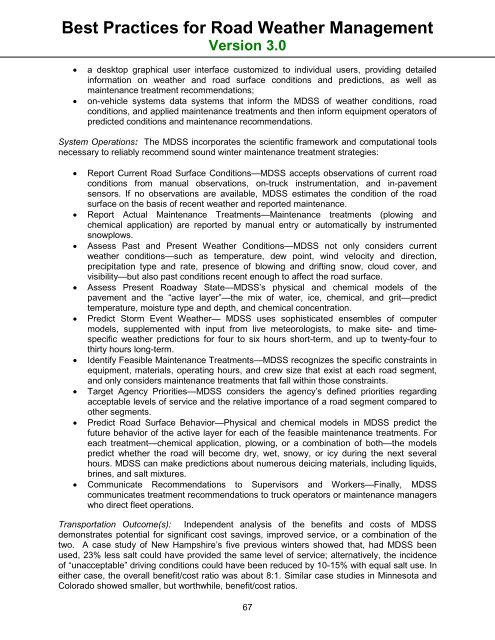Road Weather Management Program - FHWA Operations - U.S. ...
Road Weather Management Program - FHWA Operations - U.S. ...
Road Weather Management Program - FHWA Operations - U.S. ...
Create successful ePaper yourself
Turn your PDF publications into a flip-book with our unique Google optimized e-Paper software.
Best Practices for <strong>Road</strong> <strong>Weather</strong> <strong>Management</strong>Version 3.0• a desktop graphical user interface customized to individual users, providing detailedinformation on weather and road surface conditions and predictions, as well asmaintenance treatment recommendations;• on-vehicle systems data systems that inform the MDSS of weather conditions, roadconditions, and applied maintenance treatments and then inform equipment operators ofpredicted conditions and maintenance recommendations.System <strong>Operations</strong>: The MDSS incorporates the scientific framework and computational toolsnecessary to reliably recommend sound winter maintenance treatment strategies:• Report Current <strong>Road</strong> Surface Conditions—MDSS accepts observations of current roadconditions from manual observations, on-truck instrumentation, and in-pavementsensors. If no observations are available, MDSS estimates the condition of the roadsurface on the basis of recent weather and reported maintenance.• Report Actual Maintenance Treatments—Maintenance treatments (plowing andchemical application) are reported by manual entry or automatically by instrumentedsnowplows.• Assess Past and Present <strong>Weather</strong> Conditions—MDSS not only considers currentweather conditions—such as temperature, dew point, wind velocity and direction,precipitation type and rate, presence of blowing and drifting snow, cloud cover, andvisibility—but also past conditions recent enough to affect the road surface.• Assess Present <strong>Road</strong>way State—MDSS’s physical and chemical models of thepavement and the “active layer”—the mix of water, ice, chemical, and grit—predicttemperature, moisture type and depth, and chemical concentration.• Predict Storm Event <strong>Weather</strong>— MDSS uses sophisticated ensembles of computermodels, supplemented with input from live meteorologists, to make site- and timespecificweather predictions for four to six hours short-term, and up to twenty-four tothirty hours long-term.• Identify Feasible Maintenance Treatments—MDSS recognizes the specific constraints inequipment, materials, operating hours, and crew size that exist at each road segment,and only considers maintenance treatments that fall within those constraints.• Target Agency Priorities—MDSS considers the agency’s defined priorities regardingacceptable levels of service and the relative importance of a road segment compared toother segments.• Predict <strong>Road</strong> Surface Behavior—Physical and chemical models in MDSS predict thefuture behavior of the active layer for each of the feasible maintenance treatments. Foreach treatment—chemical application, plowing, or a combination of both—the modelspredict whether the road will become dry, wet, snowy, or icy during the next severalhours. MDSS can make predictions about numerous deicing materials, including liquids,brines, and salt mixtures.• Communicate Recommendations to Supervisors and Workers—Finally, MDSScommunicates treatment recommendations to truck operators or maintenance managerswho direct fleet operations.Transportation Outcome(s): Independent analysis of the benefits and costs of MDSSdemonstrates potential for significant cost savings, improved service, or a combination of thetwo. A case study of New Hampshire’s five previous winters showed that, had MDSS beenused, 23% less salt could have provided the same level of service; alternatively, the incidenceof “unacceptable” driving conditions could have been reduced by 10-15% with equal salt use. Ineither case, the overall benefit/cost ratio was about 8:1. Similar case studies in Minnesota andColorado showed smaller, but worthwhile, benefit/cost ratios.67
















